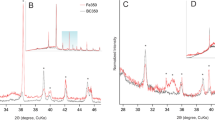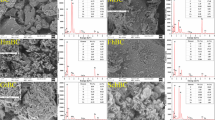Abstract
Biochar (BC) and activated carbon (AC) were both produced from corn straw. Biochar-supported zerovalent iron (BC-ZVI) and activated carbon-supported zerovalent iron (AC-ZVI) were synthesized and applied for Se(IV)/Se(VI) removal. The sorption capacity of BC-ZVI for Se(IV) and Se(VI) was reported at 62.52 and 35.39 mg g−1, higher than that of AC-ZVI (56.02 and 33.24 mg g−1), respectively, due to its higher iron content and more positive charges. The spectroscopic analyses showed that Se(IV)/Se(VI) were reduced to Se(0)/Se(-II) of less toxicity and solubility. The effects of various factors such as pH, ionic strength, co-existing cations and anions, and natural organic matter (NOM) were also investigated. Ionic strength showed no significant effect on Se(IV)/Se(VI) removal, but pH was critical. The presence of NO3− and SO42− did not cause obvious inhibition to the removal, while PO43− inhibited the sorption capacity of BC-ZVI and AC-ZVI for Se(IV)/Se(VI) significantly. Common cations (K+, Ca2+, and Mg2+) were found to slightly enhance the removal, while NOM significantly decreased the sorption capacity of BC-ZVI and AC-ZVI for Se(IV)/Se(VI). Besides, NOM showed stronger inhibition effect on AC-ZVI than that on BC-ZVI. These results indicated that BC-ZVI, compared with AC-ZVI, could be a promising sorbent to remove Se(IV)/Se(VI) due to its low cost and high efficiency.








Similar content being viewed by others
References
Chan YT, Kuan WH, Chen TY, Wang MK (2009) Adsorption mechanism of selenate and selenite on the binary oxide systems. Water Res 43:4412–4420
Chauhan D, Dwivedi J, Sankararamakrishnan N (2014) Novel chitosan/PVA/zerovalent iron biopolymeric nanofibers with enhanced arsenic removal applications. Environ Sci Pollut Res 21:9430–9442
Crane RA, Scott TB (2012) Nanoscale zero-valent iron: future prospects for an emerging water treatment technology. J Hazard Mater 211-212:112–125
Dong H, Chen Y, Sheng G, Li J, Cao J, Li Z, Li Y (2016) The roles of a pillared bentonite on enhancing se (VI) removal by ZVI and the influence of co-existing solutes in groundwater. J Hazard Mater 304:306–312
Dong H, Deng J, Xie Y, Zhang C, Jiang Z, Cheng Y, Hou K, Zeng G (2017) Stabilization of nanoscale zero-valent iron (nZVI) with modified biochar for Cr(VI) removal from aqueous solution. J Hazard Mater 332:79–86
Dries J, Bastiaens L, Springael D, Kuypers S, Agathos SN, Diels L (2005) Effect of humic acids on heavy metal removal by zero-valent iron in batch and continuous flow column systems. Water Res 39:3531–3540
Elrashidi M, Adriano D, Workman S, Lindsay W (1987) Chemical equilibria of selenium in soils: a theoretical development. Soil Sci 144:141–152
Goldhaber SB (2003) Trace element risk assessment: essentiality vs. toxicity. Regul Toxicol Pharmacol 38:232–242
Habish AJ, Lazarević S, Janković-Častvan I, Jokić B, Kovač J, Rogan J, Janaćković Đ, Petrović R (2017) Nanoscale zerovalent iron (nZVI) supported by natural and acid-activated sepiolites: the effect of the nZVI/support ratio on the composite properties and Cd2+ adsorption. Environ Sci Pollut Res 24:628–643
Hafshejani LD, Hooshmand A, Naseri A, Mohammadi AS, Abbasi F, Bhatnagar A (2016) Removal of nitrate from aqueous solution by modified sugarcane bagasse biochar. Ecol Eng 95:101–111
Huang L, Zhou S, Jin F, Huang J, Bao N (2014) Characterization and mechanism analysis of activated carbon fiber felt-stabilized nanoscale zero-valent iron for the removal of Cr(VI) from aqueous solution. Colloids Surf A Physicochem Eng Asp 447:59–66
Kang M, Chen F, Wu S, Yang Y, Bruggeman C, Charlet L (2011) Effect of pH on aqueous Se(IV) reduction by pyrite. Environ Sci Technol 45:2704–2710
Lemly AD (2002): Selenium assessment in aquatic ecosystems: a guide for hazard evaluation and water quality criteria. Springer Science & Business Media
Lenz M, Lens PN (2009) The essential toxin: the changing perception of selenium in environmental sciences. Sci Total Environ 407:3620–3633
Li H, Chen YQ, Chen S, Wang XL, Guo S, Qiu YF, Liu YD, Duan XL, Yu YJ (2017) Wheat straw biochar-supported nanoscale zerovalent iron for removal of trichloroethylene from groundwater. PLoS One 12:e0172337
Li X, Zhao Y, Xi B, Mao X, Gong B, Li R, Peng X, Liu H (2016) Removal of nitrobenzene by immobilized nanoscale zero-valent iron: effect of clay support and efficiency optimization. Appl Surf Sci 370:260–269
Liang L, Yang W, Guan X, Li J, Xu Z, Wu J, Huang Y, Zhang X (2013) Kinetics and mechanisms of pH-dependent selenite removal by zero valent iron. Water Res 47:5846–5855
Liang L, Guan X, Huang Y, Ma J, Sun X, Qiao J, Zhou G (2015) Efficient selenate removal by zero-valent iron in the presence of weak magnetic field. Sep Purif Technol 156:1064–1072
Ling L, Pan B, Zhang WX (2015) Removal of selenium from water with nanoscale zero-valent iron: mechanisms of intraparticle reduction of se(IV). Water Res 71:274–281
Liu A, Liu J, Han J, Zhang WX (2017) Evolution of nanoscale zero-valent iron (nZVI) in water: microscopic and spectroscopic evidence on the formation of nano- and micro-structured iron oxides. J Hazard Mater 322:129–135
Lv X, Hu Y, Tang J, Sheng T, Jiang G, Xu X (2013) Effects of co-existing ions and natural organic matter on removal of chromium (VI) from aqueous solution by nanoscale zero valent iron (nZVI)-Fe3O4 nanocomposites. Chem Eng J 218:55–64
Mak MS, Rao P, Lo IM (2009) Effects of hardness and alkalinity on the removal of arsenic (V) from humic acid-deficient and humic acid-rich groundwater by zero-valent iron. Water Res 43:4296–4304
Peak D, Sparks D (2002) Mechanisms of selenate adsorption on iron oxides and hydroxides. Environ Sci Technol 36:1460–1466
Schiavon M, Pilon-Smits EA, Citta A, Folda A, Rigobello MP, Dalla Vecchia F (2016) Comparative effects of selenate and selenite on selenium accumulation, morphophysiology, and glutathione synthesis in Ulva australis. Environ Sci Pollut Res 23:15023–15032
Shi L-a, Zhang X, Chen Z-l (2011) Removal of chromium (VI) from wastewater using bentonite-supported nanoscale zero-valent iron. Water Res 45:886–892
Sleiman N, Deluchat V, Wazne M, Mallet M, Courtin-Nomade A, Kazpard V, Baudu M (2017) Phosphate removal from aqueous solutions using zero valent iron (ZVI): influence of solution composition and ZVI aging. Colloids Surf A Physicochem Eng Asp 514:1–10
Su H, Fang Z, Tsang PE, Fang J, Zhao D (2016) Stabilisation of nanoscale zero-valent iron with biochar for enhanced transport and in-situ remediation of hexavalent chromium in soil. Environ Pollut 214:94–100
Sun W, Pan W, Wang F, Xu N (2015) Removal of Se(IV) and Se(VI) by MFe2O4 nanoparticles from aqueous solution. Chem Eng J 273:353–362
Tan G, Sun W, Xu Y, Wang H, Xu N (2016) Sorption of mercury(II) and atrazine by biochar, modified biochars and biochar based activated carbon in aqueous solution. Bioresour Technol 211:727–735
Tang CL, Huang YH, Zeng H, Zhang ZQ (2014) Reductive removal of selenate by zero-valent iron: the roles of aqueous Fe2+ and corrosion products, and selenate removal mechanisms. Water Res 67:166–174
Wang Q, Cissoko N, Zhou M, Xu X (2011) Effects and mechanism of humic acid on chromium(VI) removal by zero-valent iron (Fe0) nanoparticles. Phys Chem Earth 36:442–446
Wang S, Gao B, Li Y, Creamer AE, He F (2016) Adsorptive removal of arsenate from aqueous solutions by biochar supported zero-valent iron nanocomposite: batch and continuous flow tests. J Hazard Mater 322:172–181
Wang T, Liu W, Xiong L, Xu N, Ni J (2013) Influence of pH, ionic strength and humic acid on competitive adsorption of Pb(II), Cd(II) and Cr(III) onto titanate nanotubes. Chem Eng J 215-216:366–374
Winkel LH, Johnson CA, Lenz M, Grundl T, Leupin OX, Amini M, Charlet L (2011): Environmental selenium research: from microscopic processes to global understanding. ACS Publications
Wu L, Liao L, Lv G, Qin F, He Y, Wang X (2013) Micro-electrolysis of Cr (VI) in the nanoscale zero-valent iron loaded activated carbon. J Hazard Mater 254-255:277–283
Xie Y, Dong H, Zeng G, Zhang L, Cheng Y, Hou K, Jiang Z, Zhang C, Deng J (2017) The comparison of Se(IV) and Se(VI) sequestration by nanoscale zero-valent iron in aqueous solutions: the roles of solution chemistry. J Hazard Mater 338:306–312
Xu N, Zhang B, Tan G, Li J, Wang H (2015) Influence of biochar on sorption, leaching and dissipation of bisphenol A and 17α-ethynylestradiol in soil. Environ Sci Process Impact 17:1722–1730
Zelmanov G, Semiat R (2013) Selenium removal from water and its recovery using iron (Fe3+) oxide/hydroxide-based nanoparticles sol (NanoFe) as an adsorbent. Sep Purif Technol 103:167–172
Zhang Y, Wu S, Zheng H, Weng L, Hu Y, Ma H (2018) Modes of selenium occurrence and LCD modeling of selenite desorption/adsorption in soils around the selenium-rich core, Ziyang County, China. Environ Sci Pollut Res 25:14521–14531
Zhu H, Jia Y, Wu X, Wang H (2009) Removal of arsenic from water by supported nano zero-valent iron on activated carbon. J Hazard Mater 172:1591–1596
Funding
This study was supported by the National Natural Science Foundation of China (51579003) and the Shenzhen Municipal Development and Reform Commission (Discipline construction of watershed ecological engineering).
Author information
Authors and Affiliations
Corresponding author
Additional information
Responsible editor: Tito Roberto Cadaval Jr
Publisher’s note
Springer Nature remains neutral with regard to jurisdictional claims in published maps and institutional affiliations.
Electronic supplementary material
ESM 1
(DOCX 182 kb)
Rights and permissions
About this article
Cite this article
Tan, G., Mao, Y., Wang, H. et al. Comparison of biochar- and activated carbon-supported zerovalent iron for the removal of Se(IV) and Se(VI): influence of pH, ionic strength, and natural organic matter. Environ Sci Pollut Res 26, 21609–21618 (2019). https://doi.org/10.1007/s11356-019-05497-0
Received:
Accepted:
Published:
Issue Date:
DOI: https://doi.org/10.1007/s11356-019-05497-0




